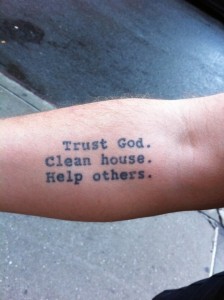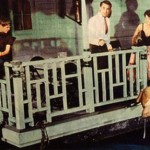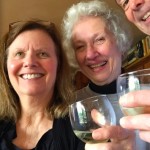 Hi Patheos community. There’s a rich and diverse conversation about spirituality going on here and I’m honored and excited to be a part of it. I’ll tell you a little about myself and what I have in mind for this blog.
Hi Patheos community. There’s a rich and diverse conversation about spirituality going on here and I’m honored and excited to be a part of it. I’ll tell you a little about myself and what I have in mind for this blog.
I was born and raised to be a rational science-loving atheist. My parents were ex-Mormons: my mom a soft agnostic with an antipathy for organized religion, my dad an angry atheist conservative who believed in science, progress and the markets. I grew up in New York’s Greenwich Village, but like a first-generation immigrant family, when I entered my home I reentered my parents’ country: Midwestern conservative land — white bread, mayonnaise, boiled vegetables and Minute Rice with a pat of margarine. (I never once spoke a curse word within those walls.) Though my dad didn’t think it had anything to do with spirituality, he went out of his way to share the wonders of nature with me and I locate my first spiritual experiences squarely in our annual summer-long camping trips through Yellowstone, Banff, the Rockies and Mammoth Caves, exploring canyons, deserts and redwood forests.
My spiritual journey began in earnest when I got sober and started building the foundation I was never given as a child. It continued through Quakerism, deep ecology, Buddhism and Catholicism, with a few detours besides. Now I’m a congregant, worship leader and cook at St. Lydia’s, an awesome dinner church in Brooklyn, NY. And I continue to spend as much time in nature as possible. I haven’t disavowed any of the steps on my journey, but draw on them all, along with other traditions I’ve encountered, from Orthodox Judaism to Zen to Pentecostalism to Sufism.
After being exposed to contemplative practice in Quakerism and exploring it further in Buddhism, nearly two decades ago I was introduced to a Christian form of meditation called centering prayer which I continue to practice and teach. I’m assistant coordinator for the New York City chapter of Contemplative Outreach, which promotes it.
My professional life has been equally eclectic. I’ve been a writer and editor for much of it, with several national columns about technology and politics, but along the way I’ve helped build a national political movement and run a political party, been a sheepherder and vegetable gardener, and worked as a videographer, software designer, stockbroker and downtempo radio DJ. A common thread in most of it — and yes, I found one — is the process of learning about stuff and then sharing that understanding with others.
A while back, I redirected my skill for writing clearly about complex issues from technology to faith, and over three years ago I started writing a column in Busted Halo on personal spirituality. Now, in this blog I’ll continue talking about tools and ideas that help on the spiritual journey, and I’ll also share reports and thoughts on just about anything that crosses my path. This is an exciting time in American spirituality. Some are bemoaning the drop in weekly church attendance and religious affiliation admitted to pollsters, but from the explosion of interest in yoga and meditation to the earnest discussions of deep issues, I see more interest and openness to faith than in several generations. It’s just not in the framework of traditional denominational religion. The culture war of the last three or four decades is of no interest to the generations that have come after. They’re just waiting to take over so we can get on with things.
I’m calling the blog “On the Way” and the Way has many meanings.
The path
Many spiritual traditions speak of a way or path or road — staying on it, straying from it, turning back in the right direction. I love this way of looking at spiritual life as a journey down a path. The sides have no walls. It’s easy to be distracted by thoughts or startled by fears and leave the path. I think of the Scott Peck book, The Road Less Travelled, and the Robert Frost poem on which its title was based, and I can’t help thinking of the opening lines of Dante’s Inferno. One translation puts it like this:
I found myself obscured in a great forest,
Bewildered, and I knew I had lost the way.
Some say the way is straight and narrow, but not only is this contradicted by my experience, it’s also a misquote of scripture. The phrase in Matthew 7:14 is “strait and narrow” which literally means narrow and narrow — a literary device often used in scripture to emphasize a point. Yes, at times the way can be narrow, but often it’s winding and confusing and overgrown. And there are forks.
In Hebrew scripture, the word shub is used countless times. It means turn around or turn back (which is also what “convert” means). The Hebrew people were always straying and coming back. It wasn’t uncommon for them to start worshipping a different God altogether and then come back. The point is not to judge but to take action. When you’re lost in the woods, berating yourself for losing the path will not help. You simply look for markers or retrace your steps. And you build practices that will help you keep on the path next time. You bring a GPS device. The metaphors are endless. Much religious noise comes from people judging themselves and others for straying from the path, instead of just turning back onto it.
I will talk about tips and tools to help in the life-long process of discernment and course correction. They come from the collective wisdom of others, have been tried in personal experience and tested through sharing in spiritual direction. Of course, like the guidance on my tattoo in this blog’s banner photo, these things are simple, but not easy.
Contemplation
The term Tao (or dao) used in some Eastern traditions means “Way” — the natural flow of things which some Christians call God’s Will. “Yoga” means yoke; a yoke steers one to stay on the path. Contemplative practices, both Eastern and Western teach you how to not fight against reality. People today spend much of their time living in and reacting to something other than reality — whether inner anxieties or the distorted materialistic culture around us. The Gita says that a life based on expectations — trying to anticipate and manipulate reality — is a life of anxiety. Drawing on two decades of contemplative meditation practice, study and teaching, I’ll be posting about finding serenity and harmony through deepening your connection with God / the ground of all being / what is.
Community
Early Christians called their new practice the Way, and I’ll be sharing from my encounters with cool experiments in Christian worship and community, including St. Lydia’s, where I am a congregant, sometime worship leader and sometime cook.
I think church attendance is down not because young adults are less interested in faith but because they are less willing to do or accept things that are empty for them merely out of obedience. Whether within mainline churches or not, call them emergent or whatever, these new forms are full of faithful people trying to reconnect with what can make spiritual community a sustaining, grounding, core part of life, rather than a checklist item for Sunday morning.
I may also talk about the Church with a capital C but only if it’s constructive; I’m not interested in criticizing and sniping.
Recovery
When the recovery movement was starting, the title of AA’s Big Book originally was to be “The Way Out.” My own spiritual journey began in earnest when I got sober and I’ll be talking about finding your way out of addiction and compulsive patterns and the ongoing journey of sober life which follows. So many spiritual themes run through the process of recovery. So many of us are prodigal sons. So many of us were lost but now are found. So many of us have been born again into a new life where our perceptions and behaviors are radically realigned. And so many of us are profoundly aware that we do not deserve any of it.
Creativity
Like nature, art has always been a part of my spiritual life, even when I didn’t see it that way. Of course, I’ve written, both prose and poetry, since my early teens. Also, growing up, I had lots of transcendent moments listening to music, first in heavy metal, then in the punk and no wave scenes. It’s no different today. Whether it’s the most ethereal sacred choral music or a shifting wall of sound from post-metal band Isis, music moves me. And singing at church every week is part of how I express and experience my faith. More recently, after a lifetime of disinterest, I’ve started to discover the transcendent in dance. Every once in a while, while watching dance, I get choked up. I can’t say why. It just happens. Art at its best is about the reach for something greater. Artists often talk about something beyond or deep within themselves coming through. (Can’t help mentioning “The Artist’s Way,” both to get the “Way” reference in and also because it has been a part of my journey.) And listeners / viewers / readers sometimes get to share in that transcendent moment. Hildegard of Bingen said it was the closest we can get to experiencing life in the Garden of Eden. I’ll be exploring the interesection of art and spirituality from both sides. (Just so you know, though, I like pop music too. There will be posts about Katy Perry and Lady Gaga. You’ve been warned.)
Notes from the along the Way
I’m also defining the Way as life in general, and this blog will include my reports from the road — both overtly faith-related and not. I believe there’s no clear line between stuff that’s spiritual and the rest. I’ve experienced transcendent moments in nature and church, listening to music and reaching consensus in a business meeting. I find lessons in reality contest shows (not reality drunk-people-being-stupid shows.) I have some hefty history in politics and sometimes (but rarely) weigh in. So this final category is a catchall for me to say whatever I feel moved to say.
I know enough to know how little I know, but I hope to share a few things that will be useful to you, and mostly I look forward to the journey. I hope you join me. Add a bookmark for patheos.com/blogs/philfoxrose and follow me on Facebook, Twitter or Pinterest. And tell me what you think in comments.












